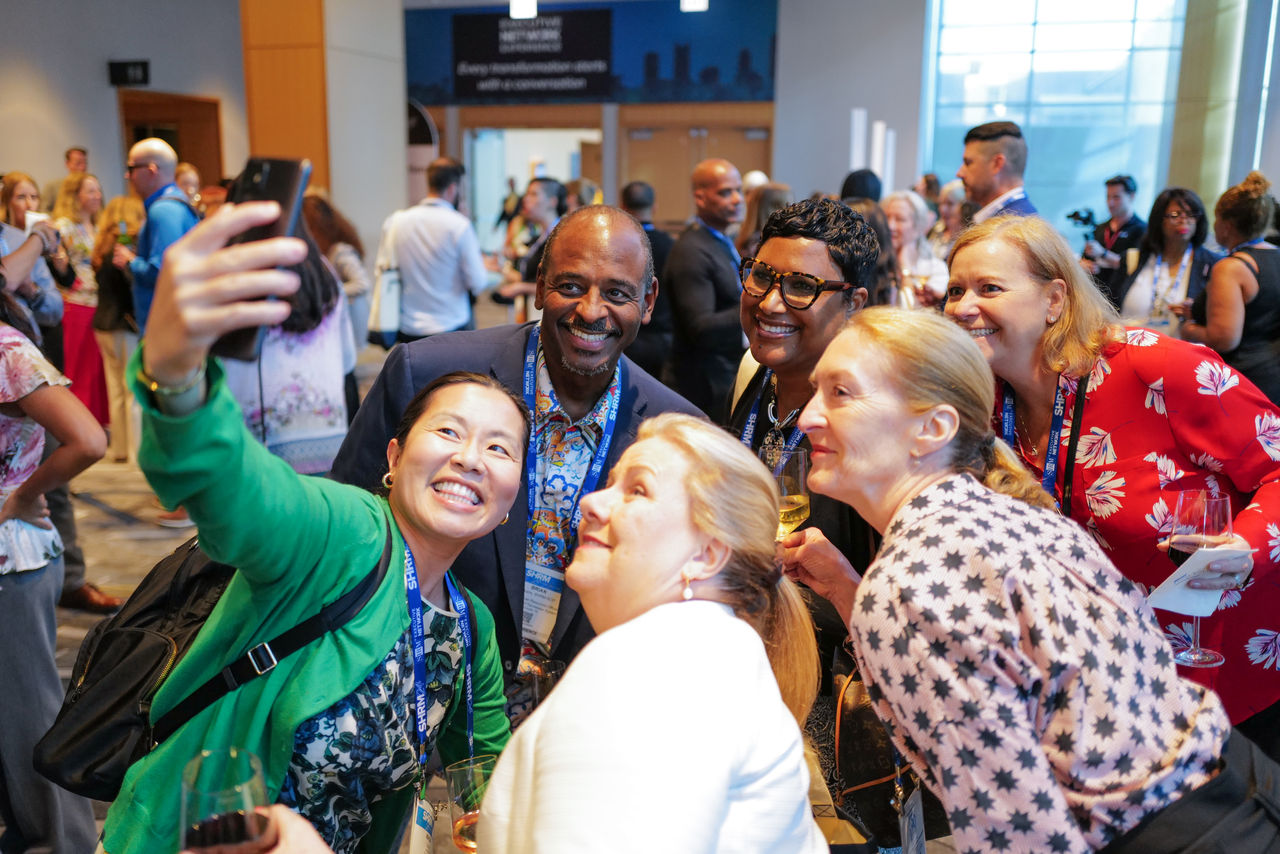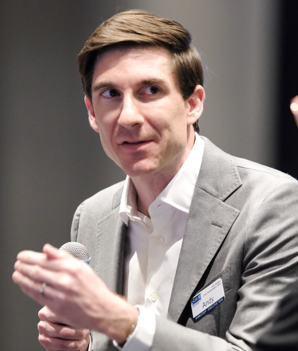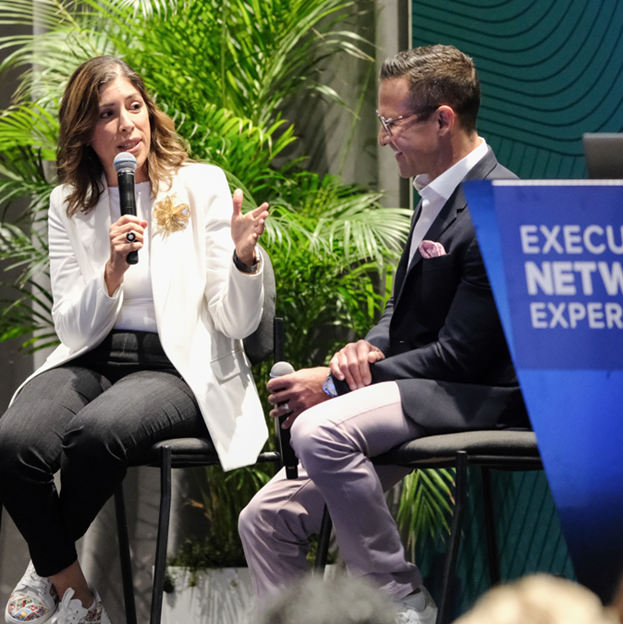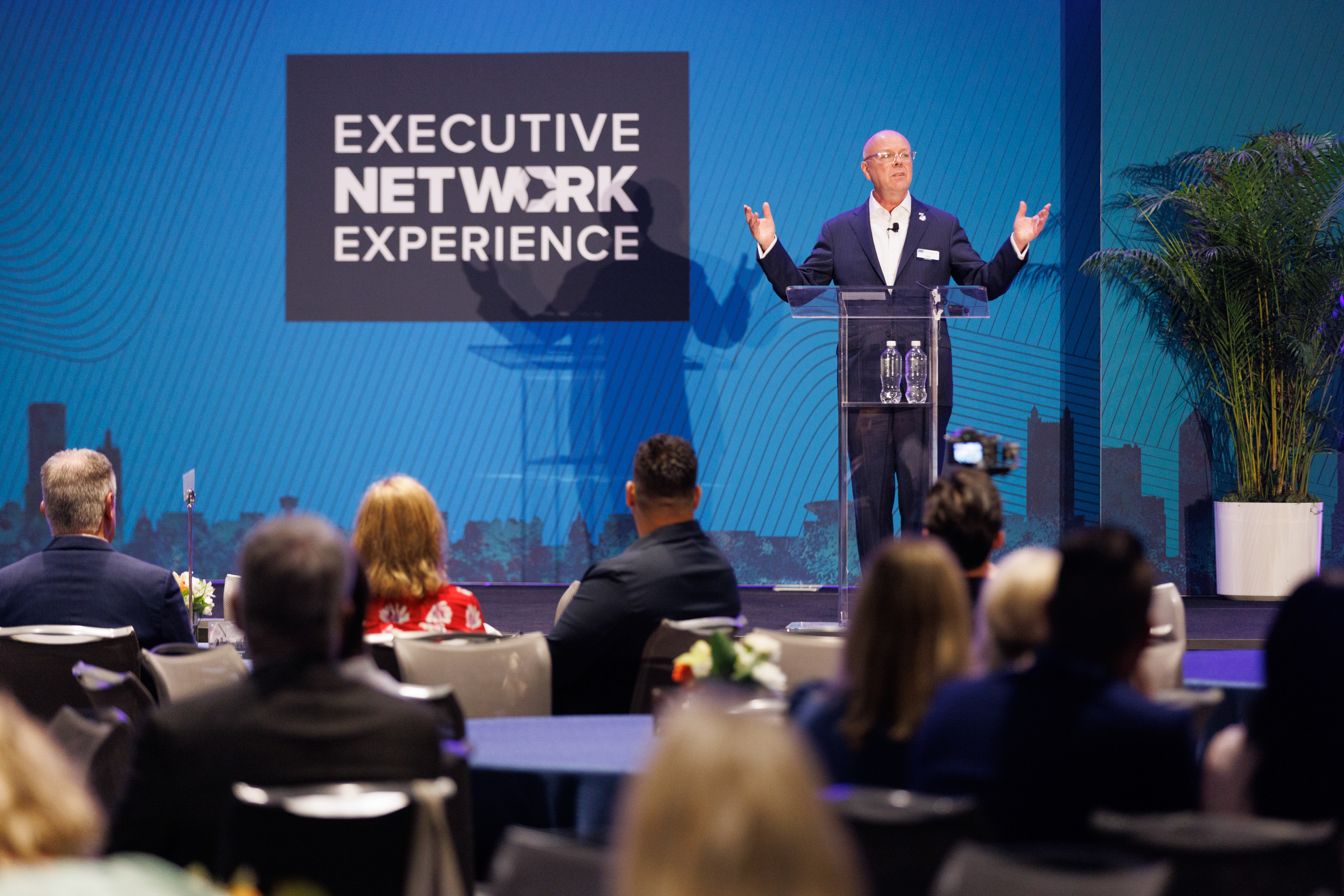6 Leadership Lessons from the SHRM24 Executive Network Experience
Wisdom and quotes from the sessions held exclusively for members of SHRM’s Executive Network at this summer’s SHRM Annual Conference & Expo in Chicago.

Last month’s SHRM Annual Conference & Expo 2024 (SHRM24) in Chicago attracted the world’s largest gathering of HR professionals under one roof. SHRM24 also included a separate “conference within a conference”—the SHRM Executive Network Experience (ENX), a gathering of more than 600 SHRM Executive Network members that featured thought-provoking sessions and networking with top executives and HR thought leaders. Here are some of the best lessons and quotes from SHRM24 ENX.
1. Self-Service ‘Tsunami’ Will Require HR Leaders to Upskill
 In the coming years, HR professionals will need to rethink the value they add to their organizations as technology allows applicants and employees to handle many traditional HR tasks themselves, said Andy Biladeau, SHRM’s chief transformation officer.
In the coming years, HR professionals will need to rethink the value they add to their organizations as technology allows applicants and employees to handle many traditional HR tasks themselves, said Andy Biladeau, SHRM’s chief transformation officer.
“The reality is that the tsunami that’s going to hit HR professionals in three or five years, maybe sooner, is that a lot of the work that we do—whether you’re a sourcer or recruiter or an instructional designer—is going to get moved to self-service for employees,” said Biladeau. “So what is the strategic value that HR then provides? It’s being a business consultant to help them understand what suite of talent solutions can help solve their business problems.”
This will require all HR professionals to become more fluent in business acumen and involved in their organizations’ financial operations.
“It’s going to take courage on behalf of HR professionals to have the confidence to upskill,” said Biladeau. He noted that becoming a full business partner “is a difficult and complex skill to build, and it takes time and reps to practice. But this is how you’ll need to operate in the future, and it’s going to come sooner rather than later.”
2. Tie Performance Reviews and Rewards to Employee Civility
Civility in the workplace is not about everyone agreeing and “yes-ing” each other. At Levi Strauss & Co., its “Profits Through Principles” mission includes evaluating employees not just on their performance, but on how they treat one another.
“We should debate. As leadership, you disagree and commit. You debate and then you walk out and are aligned,” said Levi’s CHRO Tracy Layney. “We don’t have to agree, but how we treat each other even when we disagree is the most important thing. Because that is the fabric of our culture.”
A few years ago, Layney said, Levi’s raised those behavior and values elements to become equal to performance when it came time for employee reviews.
“You’re not just being evaluated as a manager or even as an employee on what you delivered— it’s also how you delivered it. We’re now giving equal weight to how people show up in our values,” she said. “We’ve all been there when the best salesperson is kind of a jerk. You have to say it and put it in the performance management system. That’s been hugely important for us.”
3. Consider Shelving Your Degree Requirements

Do your hiring managers still click the “bachelor’s degree required” button on job openings without really thinking about the actual skills needed for the job? A series of factors—from the ongoing worker shortage to falling birth rates to soaring college costs—is gradually turning the tide on that long-held standard for professional jobs.
“It’s going to be a real challenge to get the workers we need if we’re going to rely on the four-year degree as a requirement,” said Betty Thompson, chief people officer at Booz Allen Hamilton and chair of the SHRM Board of Directors. “That’s an untenable situation for employers to have such a limited talent pool.”
She cited a recent survey that found only 1 in 4 U.S. adults believe it’s very important to have a four-year degree to get a good-paying job in today’s economy. Employers need to look more openly at alternative sources of education and training, such as military service, apprenticeships, and life experience.
Thompson said it’s important for HR leaders to not only change company policies to loosen up degree requirements, but also to make sure their managers are following through.
“The hiring managers are not changing their behaviors on this,” she explained. “So it’s the hiring managers where you really need to spend your time getting them to understand how to look at a candidate beyond the degree.”
Thompson also acknowledged that tweaking hiring standards may require additional work from employers when it comes to evaluating and training candidates.
“This trend is going to dictate that we’re going to need more sophisticated ways of assessing talent and then developing it,” she said. “And that will put a burden on employers to provide a lot of that development and training.”
4. Simplify Your Employee Surveys
In the past decade, technology has allowed organizations to survey their employees much more quickly and easily. But at some companies, including management consulting firm McKinsey & Company, that has led to almost too much data to be acted upon.
“If you’re going to ask your employees for information and data, you should be giving them something back,” said Wendy Miller, chief people officer of McKinsey in North America. “So I encourage [HR leaders] to spend a minute to ask, ‘What are we collecting today and why? What are we doing with this data and is it necessary? And where can we simplify?’ Because if your data isn’t rich and robust and usable, then it’s actually just a complicator and something you don’t need to do. So simplify is step one.”
Miller said McKinsey now focuses on four main types of surveys to get a reading on its progress with employees and clients:
- A weekly pulse survey aimed at continuous listening (what Miller called the “canary in the coal mine” survey).
- A biweekly engagement survey that measures team effectiveness and experience. The short survey (five questions) provides real-time feedback for team leaders.
- A client survey at the end of the engagement to measure business objectives and evaluate which teams are most effective for clients.
- An annual organization health index to measure and predict long-term performance and trends.
5. Project a Unified Message with Your CEO

Within the C-suite, there are bound to be vigorous debates, but it’s essential that the executive team put forth a united front once those discussions are over. That’s especially true with CHROs, said Melissa Werneck, global chief people officer at The Kraft Heinz Company.
“We have a mantra that two hats think better than one. The outcome will always be better because if [the CEO] has an opinion about something, he will share his view and maybe make me change my mind or the other way around,” said Werneck. “But when we disagree, we do so behind closed doors. Because it’s very important that the organization feels and sees the alignment between the CEO and the CHRO.”
Kraft Heinz CEO Carlos Abrams-Rivera agreed, saying, “Having a unified front helps.” Abrams-Rivera added that making big decisions together with Werneck has always been easier when he has given her space and time to reflect on important questions.
“If I’m thinking about changing something about the strategy of the company or working with the board on, I say to Melissa, ‘I’m thinking about this. Take your time and reflect on it, and in a couple days let’s talk about it,’ ” he said. “Giving space for her own reflections verses having to push to say ‘Give me the answer right now’ has helped to make sure we both come into the conversations in a better way.”
6. Employers Can Be the Spark for Immigration Reform
While immigration is a hot topic in the presidential campaign, the most important changes to the U.S. immigration system affecting employers must come from Capitol Hill. And the voices of employers and HR leaders can help shape any changes that may come in 2025 and later.
“The most fundamental changes to our immigration system can only be made by Congress,” said Bo Cooper, a partner at Fragomen, a global immigration law firm. He said the administration by itself can’t, for example, ease the path for acquiring green cards or expand the pool of work visas. Movement on any substantive legislation in Congress is unlikely this year, but compromises may be easier in the first year of a new presidency. And employers need to make their voices heard.
“You are a business. You have a voice that members of Congress will listen to,” said Emily M. Dickens, SHRM’s chief of staff, head of government affairs, and corporate secretary. “And it’s very important that you as a both a constituent and as a business leverage that voice to tell a story” about the need for immigration reform. [Read more about SHRM’s advocacy efforts to remove barriers for U.S. companies to access educated and legally authorized workers.]
___________________________________
Top Quotes from the Executive Network Experience

HR TRANSFORMATION. “We’re in the middle of a rapid business transformation. Things aren’t like they were pre-pandemic. We all feel that. And our organizations are looking at HR to revise the way work gets done in the future. That’s a daunting challenge that we’re capable of delivering.” —Jim Link, SHRM’s CHRO
* * *
THE DARKER SIDE OF AI. “We’ve started to see it in the national election, but in the next 12 to 24 months, the costs are coming so far down that we’re going to start to see deepfake [videos and images] everywhere. … And if you wait too long to respond, the effect of this disinformation will seep in and create a really corrosive effect on the workplace.” —Tim Hwang, former director of the Harvard-MIT Ethics and Governance of AI Initiative
* * *
BUSINESS AS YOUR ‘FIRST HAT.’ “HR is not the side function of business. It is the function of business. That’s why CHROs need to understand and be passionate about the business. [Our CHRO] can challenge the CFO or the chief growth officer or operations, and she can add value to all of those conversations. Being a business leader as a first hat, not as a side hat, is an important part of what I look for [in a CHRO].” —Carlos Abrams-Rivera, CEO, The Kraft Heinz Company
* * *
BAD BOSS, GOOD LESSON. “I’ve learned more from my negative experiences along the way from leaders who were either ill-prepared or not agile enough. … Sometimes those poor leaders show you more about how to be a leader and how to evolve.” —Brian Dickens, CHRO, University of Tennessee System
* * *
THOSE AREN’T ‘SOFT’ SKILLS. “We shouldn’t be calling them ‘soft skills’ anymore. Those are professional skills. Those are critical skills that people need to have today to be successful. … And we should be hiring for potential as opposed to perfection. Look for people who are lifelong learners, who have shown flexibility, who can ask thoughtful questions, who can make informed decisions. These are all things that AI won’t be able to do.” —Betty Thompson, chief people officer, Booz Allen Hamilton
* * *
BUILD YOUR AGILITY MUSCLES. “Transformation is no longer about going from point A to point B … because there is just so much disruption going on. Businesses are transforming themselves at record speeds. So what transformation and change management is about today is, ‘How do we actually build organizational agility?’ … Building that mindset into the organization is truly the demand of change management now.” —Andy Biladeau, SHRM’s chief transformation officer



